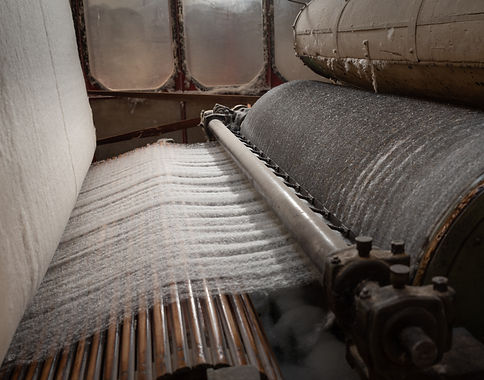
The wool felt we produce is a 100% natural and versatile material and its acoustic and heat-retaining properties make it the perfect answer to the challenges of the creative industry.
Organic and biodegradable
Fully customizable
Sustainability reports
Sustainability report
Oeko-Tex 100 Certificate
Code of Conduct
How it is
made
Wool felt has properties such as unique durability and resilience. The waviness of the fibers provides natural flexibility. This flexibility makes it resistant, while the outer covering of the fibers forms a protective film layer called Lanolin. This thin waxy coating on the wool fibers makes the wool waterproof. Wool can be dyed well, as the natural dyes penetrate right up to the middle of the fiber and the color becomes intense and permanent. Since all wool fibers have a natural moisture content, they are perfectly fireproof without any chemical treatment.

1. Sheep shearing
Sheep are shorn once a year, usually in spring, to prevent them from overheating during this season while allowing their fleece to regrow by winter.

2. Wool cleaning
The shorn wool is washed to remove wool grease (lanolin) and other animal-related impurities. After this vegetable matters can be removed through carbonization or combing.

3. Carding
The carding machine aligns the unruly wool fibers into an organized sheet forming a continuous wool fleece that is rolled up ready for the next step.

4. Felting
Under the influence of high temperature and steam the scales of the wool fibers open up. With the rubbing motion of the felting machine, the fibers interlock, forming felt.

5. Fulling
.png)
To achieve greater density the felting process is followed by so-called fulling. During this process the felt shrinks under repeated beating, thus densifying the material. Fulling continues until the desired density is reached.

7. Drying

6. Dyeing
For dyeing the finished wool felt we use dyes certified under the Oeko-Tex Standard 100. Custom color dyeing is also available.
8. Cutting
The finished felt is dried trimmed and nopped (surface treatment). The production process is completed by ironing or for thicker industrial felts, pressing.
The finished product is cut or die-cut according to specific needs. Upon request we also offer further processing of the felt, including custom cutting, tailoring and sewing.
Tradition
and durability
Our company, which operating for over 125 years, specializes in the production of natural wool felt. This timeless material stands out not only for its durability and fire-resistant properties but also for its unique aesthetics and quality. The durability of wool felt perfectly reflects our company's traditions: long-lasting, durable and reliable, just like Multifelt.
Unique solutions with Hungarian production
Multifelt is not only the only felt factory in Hungary, but there are hardly any such factories in the Central European region. We are also considered a rarity among European factories as we are flexible in a large color range, and even undertake the production of smaller quantities tailored to individual needs unlike large manufacturers. In addition our products are available in a wide range of standard colors.
Natural and sustainable solutions
Flexibility and uniqueness above all else
Environmental awareness is essential today and Multifelt is at the forefront of this. Our products are made from natural wool which is not only sustainable, but also an environmentally friendly alternative to plastic felts. Recyclability and the use of renewable raw materials ensure that our products meet modern environmental and sustainability requirements.
Multifelt is committed to meeting the needs of every customer to the fullest. Our services include custom small-batch production where a wide range of colors, sizes and shapes are available. Thanks to our flexible minimum order options, we offer an ideal solution even for smaller companies or unique projects.





